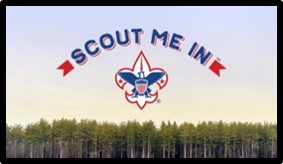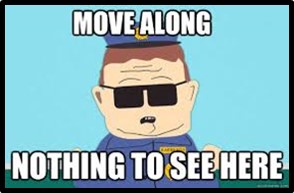Monday Author: Susanne Skinner
 In February the Boy Scouts of America became the BSA, welcoming girls into the organization. The decision changes the one-hundred-year-old boys only rule and offers girls the opportunity to attain the highest rank of Eagle Scout. Their new name is Scouts BSA. The rebranding is paired with a new ad campaign called “Scout Me In” designed to appeal to both boys and girls.
In February the Boy Scouts of America became the BSA, welcoming girls into the organization. The decision changes the one-hundred-year-old boys only rule and offers girls the opportunity to attain the highest rank of Eagle Scout. Their new name is Scouts BSA. The rebranding is paired with a new ad campaign called “Scout Me In” designed to appeal to both boys and girls.
Except…. nothing’s changed. They changed the name of the program, dropping the word boy, but the organization remains the same. Each chartering organization retains the right to choose whether it will add girls to its troops or packs.
Are we really seeing a New Boy Scouts of America?
Boy Scouts: Same Old Same Old
As a rebranding effort, the new name is weak and lacks impact. By retaining its gender-specific initials, it’s far from inclusive. Adding girls is just…an add on, sending a message to any would-be female members that it’s the same old, same old.
Nationally the BSA is dealing with declining numbers. At their peak they had 4 million members, and today it has dropped to 2.3 million. Because of the decrease it begs the question of need versus want. If they truly wanted to create an organization welcoming both genders equally they should have gone with Scouts USA, followed by a gender-neutral set of programs.
What has really happened is the Boy Scouts of America will no longer have a program called the Boy Scouts, because it’s no longer just for boys. But they’re still keeping the “Boy” in the organization’s name, demeaning the entire message, which was pretty lame to begin with.
Furthermore—they didn’t discuss it with the Girl Scouts! There we no talks of joint membership, assimilation or program structure. Just an announcement from the Boy Scouts that they were accepting girls.
Somebody needs a new PR team.
What Do the Girls Say?
 Girl Scouts have the same issue of declining membership, 13.7 percent since 2014. According to GSA leadership they were “blindsided” by the Boy Scouts’ move to add girls to their organization. Since both organizations have steadily dropping numbers they are effectively competing for the same new members.
Girl Scouts have the same issue of declining membership, 13.7 percent since 2014. According to GSA leadership they were “blindsided” by the Boy Scouts’ move to add girls to their organization. Since both organizations have steadily dropping numbers they are effectively competing for the same new members.
“Girl Scouts is the premier leadership development organization for girls,” Sylvia Acevedo, CEO of Girl Scouts of the USA, told the media after the Boy Scouts announcement. “We are, and will remain, the first choice for girls and parents.”
The Girl Scouts reacted by creating new badges that focus on STEM achievements and outdoor skills and added a Ranger Program affiliated with the National Park Service.
They also responded to the name change with a blog post entitled
“No Contest: Girl Scouts is the Best Leadership Organization for Girls. The need for female leadership has never been clearer or more urgent than it is today—and only Girl Scouts has the expertise to give girls and young women the tools they need for success.”
Nothing to See Here
The Boy Scouts were founded in 1910, followed by the Girl Scouts in 1912. Both organizations operated as separate entities and were gender specific in their structure and programs. In fact, Robert Baden Powell, the original founder of the Boy Scouts in England, created a separate organization called Girl Guides for young women. Juliette Low brought the idea to the United States and called it Girl Scouts of America.
 Each organization tailored their programs to the boys and girls they represented, emphasizing community service, relationships and leadership development.
Each organization tailored their programs to the boys and girls they represented, emphasizing community service, relationships and leadership development.
The BSA has not offered any detail on how they will adapt their programs to young girls, believing they will join because it is an “iconic organization” where they too can achieve the “coveted rank of Eagle Scout.”
There is still a lot of work to be done if this is going to succeed.
Mixed Reactions
The announcement drew praise from scouting leaders, mixed reactions from women’s groups and indirect criticism from Girl Scouts USA.
The social media backlash has been mixed. Critics refer it is as the loss of a long-standing tradition, calling it the “wussification of America.” Supporters say it’s long overdue, advocating equality and inclusion are the right way to go.
Some say it’s a move of political correctness that will empower young women but others worry that what has long been a boy-centric curriculum will not succeed when blended to include girls. One of the harshest criticisms came from Eagle Scouts who claim the prestige of their hard-earned award will be diminished.
Zach Wahls, co-founder of the nonprofit Scouts for Equality, said the development was “yet another step forward,” for the Boy Scouts.
The National Organization for Women adopted a wait and see attitude with their statement: “It’s a good thing in that the Boy Scouts have a long history of discrimination and they are taking action,” NOW President Toni Van Pelt said. “The devil is in the details and we need to wait and see how this plays out.”
The New Face of Scouting
Both organizations have been forced to find new ways of bringing kids and families into scouting as membership steadily drops. But the change also reflects shifting social and cultural norms that expect programs to be equally available to boys and girls. Political correctness aside, does this really make sense?
As it currently stands, the name change was just that. There have been no new girl-focused programs announced and the motivation to create an inclusive organization seems to be a business-driven decision.
Yes, girls can now join the BSA—but should they want to?
